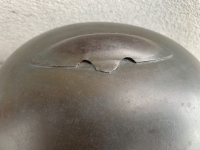BACKGROUND: The French were the first to have a general issue,
"modern ", steel helmet in WWI and developed the classic "Adrian" style helmet in early 1915 followed by the British army later that year and by the German’s in 1916. The Russians were given two million "Adrian" helmets by the French as a temporary solution till Russia could begin production of their own helmet. These helmets featured the metal comb protrusion on the top which was meant to help infantrymen battle against saber blows against mounted cavalry units. This sort of rooster comb also allows for air circulation as there is a gap between the base and top of the helmet. In 1916 the Russian also produced their own pattern helmet. In 1936, the distinctive SSCH-36 (Stalnoi Schlem) pattern went into production until the SSCH-39, whose shell design was used until 1968. The SSCH-39 was replaced by the SSCH-40, which, although outwardly identical, had a different liner arrangement, and a correspondingly different rivet pattern.
The years in which the SSCH-36 was being manufactured from 1936-39 were more so a time for Stalin’s industrial and agricultural build up leaving the military lagging far behind other European industrialized nations. As a result relative to German, American, Italian etc very few SSCH-36 helmets were ever produced and those that were mostly ended up being melted down and recycled into M40 designs in order to improve Soviet standardization.
DESCRIPTION
I usually list mainly only German helmets but these are my next best personal favorite to collect. There are just not that many of these out there as most were crushed and recycled into Soviet industry or ended up buried in the Balkans or in the far eastern steppes of Russia during their war with Japan which is why you see so many ground dug rust buckets but so few untouched originals like this fine example.
This fine example has nearly 75% of it's original factory moss green paint still in tact with only minor areas of surface bluing but no active rust or pitting anywhere to be found. It's that nice smooth brown stabilized surface rust like you see looking down at an old manhole cover. The original canvass bowl shaped liner is 100% untouched since the late 1930's. One of the nice things about these Russian helmets is that the liner systems were riveted in place and can't be messed with only permanently removed or left alone. Historians tell us that a lot of these helmets when used in winter conditions had the liners yanked out as to allow for a soft Ushanka rabbit fur hat to be worn underneath to prevent from freezing to death. I would have done the exact same thing. The canvass chinstrap is fully in tact and has never been altered or shortened and is permanently riveted to the chinstrap bales. The Russian helmet came in 4 sizes and this one is a nice size 3 large that fits my head and I'm a German size 66/59. The side lot number is 3-4987 and the 3 is obviously the size and 4987 must be a quality control lot number similar to what the Germans used. I know it's tempting to pay $5 and buy a red star paper template to decorate up the front but from the hundreds of original photos of Russian soldiers I've seen very few actually had that red commie star. You see it mostly in large parade gatherings but rarely in the field. If you look at enough photos you might conclude that as a Russian solider when in public view i.e. parade squares etc. yes go with the red star but in front line combat conditions get rid of the damn thing!!! Rub it away with some diesel or just repaint it again crudely by horse hair brush.
A very difficult example to upgrade and a worthwhile investment considering that the world is mass printing money but these helmets will always be in finite supply.
$1000 - SOLD - Robert V.
Please call, text or email me if interested.
Tel/Text: 1-438-502-5052
Email Us: helmetsofwar@gmail.com






